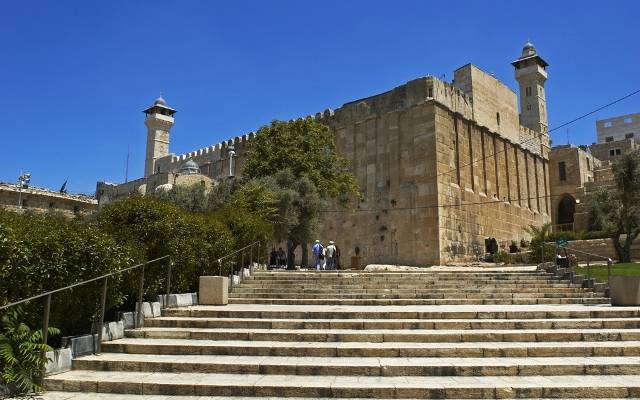A PA committee condemned the move, saying that the renovation is an attack on the exclusive right of the Muslims to enter the site. Are there no disabled Muslims wishing to enter?
By Maurice Hirsch, Adv., Palestinian Media Watch
The decision of the Israeli authorities to make the Cave of the Patriarchs in Hebron accessible for the disabled has infuriated the Palestinian Authority. Just recently, a PA committee condemned the move, saying that it would “harm the Ibrahimi Mosque”- the name the Palestinians use for the site – and that the renovation is an attack on the exclusive right of the Muslims to enter the site:
“The [PA] presidential committee for church affairs in the State of Palestine condemned the recurring violations, crimes, and acts of Judaization that the occupation authorities are committing against the Ibrahimi Mosque … and the falsification of its Islamic and cultural nature by building an elevator for settlers as part of its declared plan to take control of it and strengthen its settlement in Hebron.
In a statement issued by its President [and] Director-General of the Palestine National Fund (PNF) Ramzi Khouri yesterday, Friday [Aug. 13, 2021], the committee emphasized that harming the Ibrahimi Mosque is an attack against the Muslims’ pure right to it.”
[Official PA daily Al-Hayat Al-Jadida, Aug. 14, 2021]
As part of its campaign to prevent making the site disabled accessible, the PA-controlled Municipality of Hebron, together with others, even appealed to the Israeli courts against the decision. After the Jerusalem District Court rejected their appeal, the Municipality then appealed to Israel’s Supreme Court (Administrative Petition Appeal 1883/21 municipality of Hebron Et. al v The [Israeli] Minister of Defense).
In a decision handed down on November 4, the Supreme Court rejected the appeal, paving the way for finally providing for the needs of the disabled to visit the site.
Presenting the accessibility issue, the court noted that at present the Cave of the Patriarchs is inaccessible to people with disabilities. To access the outside courtyard to the site, one must first go up 3 sets of stairs, each with 8 steps. From that courtyard, one must then alight another 59 steps. The areas subject to the appeal would serve to build a ramp alongside the first 3 sets of stairs and an elevator into the building itself.
Having presented the basic problem, the court then proceeded to detail the claims of the Municipality of Hebron – headed by the convicted murderer of six, Tayseer Abu Sneineh – and the reasons to reject them.
Rejecting the PA claim that making the site accessible to people with disabilities would damage the holy character of the site, the court noted that since the site is holy not only to Islam but also to Judaism, if the work would truly damage the nature of the site, the Jews would also be objecting to the work.
In response to the PA claim that the decision to make the site accessible to people with disabilities encroached upon its jurisdiction, the court explained that over the years there have been multiple attempts on the side of the Israeli authorities to coordinate the work with the PA Municipality and the Waqf, but that both organizations have refused to respond.
The Court noted that it was difficult to reconcile the fact that on the one hand the PA Municipality has refused to participate in making the site accessible, but on the other hand is complaining that the Israeli authorities had “usurped” its claimed authority and jurisdiction.
Rejecting the claim that the decision to make the Cave of the Patriarchs disabled accessible would breach the Protocol Concerning the Redeployment in Hebron, reached in January 1997 (see not below), the court adopted the reasoning of the District Court saying that maintaining the status quo of religious sites does not exclude carrying out essential works to make the sites disabled accessible.
Having rejected the previous arguments, the court noted that during the hearing, the municipality had subsequently rescinded its objection to making the site disabled accessible but had continued in their objection to the specific plans chosen.
While noting that on principle, the court does not serve as an alternative to the planning authorities, it nonetheless examined the different considerations taken into account – which included the engineering complexity, the environmental effect from an archeological/conservationist point of view, the ease of use, and the cost – and found them to be reasonable and in accordance with the law.
As regards the construction, the court also noted the commitment of the Israeli authorities that the work to construct the elevator shaft would be done carefully, using hand tools and under the constant guidance of the Staff Officer for Archeology.
Finally, the court noted that while on a day to day basis the use of the Cave of the Patriarchs is divided between Jews and Muslims – The Jews have regular access to the relatively small halls of Abraham and Sarah, Jacob and Leah and the court yard between them and the Muslims have access to the much larger hall of Isaac and Rebbeca and the surrounding courtyards (see floor plan below) – there are 10 days a year during which the entire Cave is used only by Muslims. On those days, in addition to the already existing disabled access to the hall of Isaac and Rebecca, the Muslim worshippers would also be able to use the new provisions.
As Palestinian Media Watch exposed, the PA rhetoric against the move to make the Cave of the Patriarchs disabled accessible has even included accusing Israel of committing a “war crime” and claiming that the move is “tantamount to igniting religious war.” While the PA claims that making the Cave of the Patriarchs accessible for the disabled is “Judaization” of the site, for an expanded history of the 3,000 year old Jewish presence in Hebron see this PMW report.
